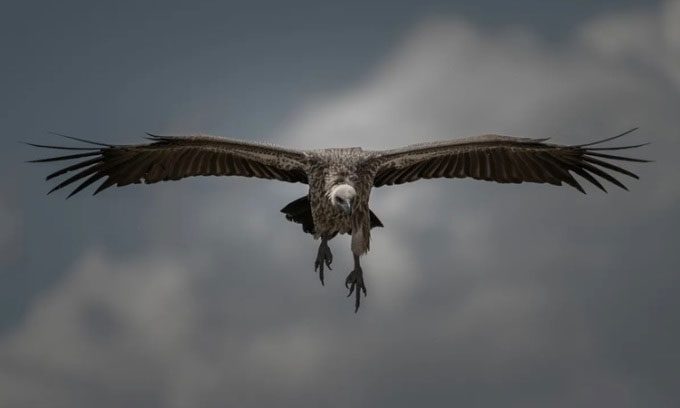The bird that holds the record for the highest flight in the world is the Rüppell’s griffon vulture (Gyps rueppellii), capable of reaching an altitude of 11,300 meters.
In 1973, a Rüppell’s griffon vulture collided with a commercial airplane at an altitude of 11,300 meters over Côte d’Ivoire in West Africa. Although one of the engines was damaged, the aircraft landed successfully. However, the bird was not as fortunate. All that remained of it were five intact feathers and 15 incomplete ones, enough for species identification and to confirm the record, according to IFL Science.

Rüppell’s griffon vulture flying in the air. (Photo: Andres Mena Photos).
Rüppell’s griffon vultures are highly social and mate for life. Both male and female birds participate in caring for their young for the first 150 days of life. Native to the Sahel region of Africa, which stretches between the Sahara Desert and the Sudanian savanna, the habitat of this vulture includes several countries such as Zimbabwe, Senegal, and Ethiopia. Occasionally, they can also be found in the Mediterranean region of Spain.
These appearances may become rarer in the future as the Rüppell’s griffon vulture is listed as critically endangered on the International Union for Conservation of Nature (IUCN) Red List. Like many African bird species, they are threatened by habitat loss, hunting activities, and the decline of their primary food source, carrion.
Rüppell’s griffon vultures also face significant challenges due to poisoning, particularly in East Africa, mainly from the pesticide carbofuran. However, the international organization BirdLife International also emphasizes the role of diclofenac. This anti-inflammatory drug, which can be used in veterinary treatment, can be fatal to Rüppell’s vultures if they ingest the carcasses of animals treated with the drug.
Rüppell’s griffon vultures stand nearly one meter tall with their distinctive bald heads. This adaptation arises from their tendency to bury their heads into the carcasses of prey while feeding. Despite having a wingspan of over two meters, they rarely flap their wings while flying. Even when not causing issues for commercial pilots, the Rüppell’s griffon vulture often reaches impressive altitudes, taking advantage of strong thermal currents while soaring over the ground in search of food.
Other bird species that could compete for the title of highest flying bird include the white-naped crane (Grus grus), which can fly at an altitude of 10,000 meters while avoiding eagles in the Himalayas, and the bar-headed goose (Anser indicus), which can reach a maximum altitude of 7,300 meters and possesses oversized lungs to cope with low oxygen levels.


















































